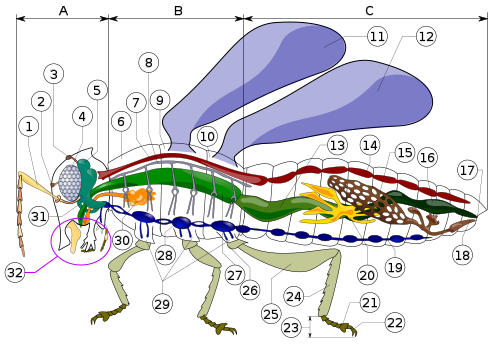This article needs additional citations for verification .(February 2016) |
The supraesophageal ganglion (also supraoesophageal ganglion, arthropod brain, or microbrain [1] ) generally consists of a set of three fused pairs of ganglia, which constitute the brain in most insect species and in some other closely related arthropods, such as myriapods and crustaceans. It receives and processes information from the first, second, and third metameres. The supraesophageal ganglion lies dorsal to the esophagus and consists of three parts, each a pair of ganglia that may be more or less pronounced, reduced, or fused depending on the genus:
Contents

- The protocerebrum , associated with the eyes (compound eyes and ocelli). [2] Directly associated with the eyes is the optic lobe, as the visual center of the brain.
- The deutocerebrum processes sensory information from the antennae. [2] [3] It consists of two parts, the antennal lobe and the dorsal lobe. [3] [4] [5] The dorsal lobe also contains motor neurons which control the antennal muscles. [6]
- The tritocerebrum integrates sensory inputs from the previous two pairs of ganglia. [2] The lobes of the tritocerebrum split to circumvent the esophagus and begin the subesophageal ganglion.

The subesophageal ganglion continues the nervous system and lies ventral to the esophagus. Finally, the segmental ganglia of the ventral nerve cord are found in each body segment as a fused ganglion; they provide the segments with some autonomous control.